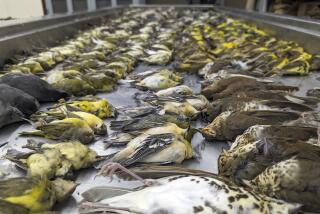Injuries From Falling Ice Give Chicagoans Heads-Up
- Share via
CHICAGO — Sonny Skinner and a 4-foot chunk of ice crossed paths Thursday. The ice whistled downward from a Chicago skyscraper, missing Skinner by less than a foot.
“It’s only by the grace of God that I wasn’t killed,” he said. Skinner cringed as shards of ice hit his legs, but then pulled his jacket over his head and ran.
Skinner was part of a seasonal ritual in Chicago that has people sidestepping, weaving or flat-out sprinting down sidewalks to avoid falling ice. Warning signs crop up around city buildings at the first freeze and remain until spring.
Skinner, however, was well outside the area roped off with yellow “Caution Falling Ice” signs. “They didn’t do me much good right there,” he said. “There’s nothing they can do.”
While most of the ice falls harmlessly to the pavement, one downtown hospital reported treating eight people for injuries related to falling ice Thursday.
Four of those injured suffered cuts that required stitches, but all of the injuries were minor, said Dr. Demetrios Kyriacou at Northwestern Memorial Hospital.
And in the Windy City--where ice can fall, say, 40 to 60 floors and get blown sideways the length of a city block before crashing to the ground--such accidents can have tragic consequences.
A Wisconsin family settled a $4.5-million lawsuit last year after a microwave-size piece of ice fell from the Neiman Marcus building, crushing the skull and vertebrae of Donald Booth, 48. He was killed instantly.
Chicago lawyer David Wise, who represented Booth’s family, said his office is almost always handling a case involving falling ice.
New York and Minneapolis also report injuries from falling ice. In central Moscow, with its many slanted roofs, people die every year, stabbed or smashed by icicles. In Kiev, Ukraine, workers climb on roofs to loosen accumulated ice and snow.
Chicago in the past has closed hazardous sections of downtown, but that hasn’t happened this year. After a major storm dumped more than a foot of snow this week, the city issued a reminder to building owners to watch for buildups of ice and snow.
“City inspectors assigned to monitor facades of downtown buildings for cracks or fissures also look for snow buildup or dangerous ice,” said Kristen Lobbins-Cabanban, spokeswoman for the Buildings Department. “They go into buildings and speak with building managers about potential problems.”
Responsibility for the problem rests with building owners, Lobbins-Cabanban said.
More to Read
Sign up for Essential California
The most important California stories and recommendations in your inbox every morning.
You may occasionally receive promotional content from the Los Angeles Times.










